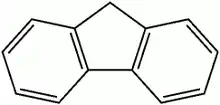F number (chemistry)
F number is a correlation number used in the analysis of polycyclic aromatic hydrocarbons (PAHs) as a descriptor of their hydrophobicity and molecular size.[1] It was proposed by Robert Hurtubise and co-workers in 1977.[2]
Calculation
The F number is calculated using the formula:
where:
- B2 is the number of double bonds
- C12 is the number of primary carbon and secondary carbon atoms
- R is the number of non-aromatic rings.
Correlation
It has been found that the F number linearly correlates with the log k' value (logarithm of the retention factor) in aqueous reversed-phase liquid chromatography. This relationship can be used to understand the significance of different aspects of molecular architecture on their separation using different stationary phases.[3] This size analysis is complementary to the length-to-breadth (L/B) ratio, which classifies molecules according to their "rodlike" or "squarelike" shape.[4]
References
- Jinno, Kiyokatsu; Okamoto, Mitsuyoshi (1984). "Molecular-shape recognition of polycyclic aromatic hydrocarbons in reversed phase liquid chromatography". Chromatographia. 18 (9): 495–498. doi:10.1007/BF02267234.
- Schabron, John F.; Hurtubise, Robert J.; Silver, Howard F. (1977). "Separation of hydroaromatics and polycyclic aromatic hydrocarbons and determination of tetralin and naphthalene in coal-derived solvents". Anal. Chem. 49 (14): 2253–2260. doi:10.1021/ac50022a037.
- Jinno, Kiyokatsu; Okamoto, Mitsuyoshi (1984). "Correlation of the retention data of polyaromatic hydrocarbons obtained on various stationary phases used in normal- and reversed-phase liquid chromatography". Chromatographia. 18 (1): 44–46. doi:10.1007/BF02279465.
- Rahman, M. Mizanur; Takafuji, Makoto; Ansarian, Hamid R.; Ihara, Hirotaka (2005). "Molecular Shape Selectivity through Multiple Carbonyl−π Interactions with Noncrystalline Solid Phase for RP-HPLC". Anal. Chem. 77 (20): 6671–6681. doi:10.1021/ac050851v.
